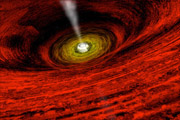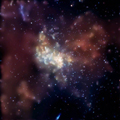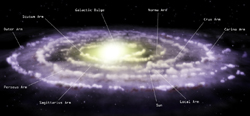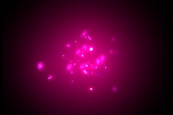An overview of the Chandra mission and goals, Chandra's namesake, top 10 facts.
Classroom activities, printable materials, interactive games & more.
Overview of X-ray Astronomy and X-ray sources: black holes to galaxy clusters.
All Chandra images released to the public listed by date & by category
Current Chandra press releases, status reports, interviews & biographies.
A collection of multimedia, illustrations & animations, a glossary, FAQ & more.
A collection of illustrations, animations and video.
Chandra discoveries in an audio/video format.
The Wonderful (And Fearful) Dark Side
October 22, 2003 ::

Johannes Kepler
Credit: Johnnes Kepler Gesammelte Werke , C. H. Beck, 1937 |
"Deep into that darkness peering, long I stood there wondering, fearing." (E. A. Poe, The Raven)
Peering deep and long into the darkness is what astronomers do. What they have found in recent years certainly inspires a sense of wonder, while attesting to major unseen features of the universe - dark stars, dark matter and dark energy.
About four hundred years ago, the great astronomer, Johannes Kepler, realized that the very fact that the sky is dark at night was telling something profound about the nature of the universe.
If the universe were infinite and uniformly populated with luminous stars, Kepler reasoned, then any line of sight must eventually encounter the surface of a star. Therefore, no dark gaps should lie between the stars, and the sky should not be dark at night! Kepler's solution was that the universe is finite rather than infinite. However,
Einstein's theory of gravity showed that a finite universe must be a curved one in which light does not escape, so Kepler's solution did not work.
Absorption of distant light by interstellar gas will not work either, because the gas would eventually heat up and glow. Clustering the stars and galaxies with progressively larger gaps between them could work in principle, but this would violate observations of galaxies and cosmic background radiation which show that the universe is uniform on the largest scales.
The solution, hinted at in an essay by Edgar Allen Poe a century and a half ago, is that stars do not live forever. Their lifetime is too short, and the time it takes for light to travel to Earth from the distant reaches is too long for starlight to fill the vast spaces with enough radiation to keep the sky from being dark at night. The expansion of the universe helps, also.

Schematic of a Black Hole
Illustration: CXC/A.Hobart |
Since Newton explained gravity, astronomers have speculated that some stars might have collapsed and become dark, that their gravity might be so strong that nothing, not even light, could escape. These dark stars are called black holes and in the last thirty years astronomers have amassed an impressive body of evidence for the existence of two types of black holes.
Stellar-mass black holes are presumably the collapsed remnants of stars at least 20 times more massive than the Sun. The best stellar black hole candidates discovered so far are in a close orbit around a normal star, and are pulling it apart. As matter from the normal star falls toward the black hole, it emits observable X-radiation before it disappears into the black hole, never to return. The number of these fearsome gravitational goblins in our Milky Way galaxy is estimated to range from tens of millions to hundreds of millions.
Radio, infrared, optical and X-ray studies show that a much larger type of black hole, called a
supermassive black hole, exists at the center of most galaxies. These black holes have masses ranging from a few million to a few billion times the mass of the Sun. The
supermassive black hole at the center of the Milky Way Galaxy is a featherweight, with a mass of only about 3 million solar masses.

Sagittarius A*
Credit: NASA/CXC/MIT/F.K.Baganoff et al. |
How supermassive black holes are formed is not understood. They could have formed through the direct collapse of a cloud of matter at the center of a galaxy, or through the merger of black holes, or by the gradual accretion of gas from the surrounding galaxy, or by a combination of all of the above. Their growth could depend on the availability of surrounding gas, or nearby black holes that could be captured, or the rate of rotation of the host galaxy.
One important clue that has been discovered in the past few years is that the mass of a galaxy's central supermassive black hole is roughly related to the mass of the central bulge of the galaxy. For example, the Milky Way Galaxy has a relatively small bulge, and a smaller supermassive black hole. Any successful theory of the formation of supermassive black holes will have to account for the black hole/bulge relationship.

Milky Way Illustration
Credit: CXC/M.Weiss |
Results from Chandra, other X-ray telescopes, and the Hubble Space Telescope have raised the possibility that yet another type of black hole may exist. These black holes, whose masses could be in the range of several hundred to several thousand solar masses, are called
intermediate-mass black holes. They could be the remains of extremely massive stars thought to have formed early in the evolution of the universe. Or they could have formed through the rapid merger of many smaller black holes in the centers of dense star clusters. Or they may be unusually energetic stellar black holes. The evidence is not strong enough at this point to know.
Stellar, supermassive, and possibly intermediate mass black holes are examples of a ghostly type of matter called
dark matter. Simply put, dark matter is matter that cannot be seen with any type of telescope, but it can be detected through its gravitational effects. These effects are observed as peculiarities in the orbits of stars and gas in galaxies and galaxy clusters. Astronomers have come to the humbling conclusion that most of the matter in the universe, approximately 80 percent, is in the form of dark matter. Humbling because they do not know what it is. The two known types of dark matter, massive neutrinos and black holes, are thought to be a minor portion of the overall dark matter budget.

Dark Energy
Credit: NASA/CXC/K.Divona |
Whatever dark matter is, it has shaped the universe as we know it. Without the gravitational pull of dark matter, it is likely that the universe would have remained too smooth to form galaxies, stars, and planets.
Through observational study of galaxies and galaxy clusters, and theoretical studies of how to form these structures, astrophysicists can determine the broad outlines of what dark matter must be like. The candidate that best reproduces the observed universe is a general class of dark matter called "cold dark matter" - hypothetical subatomic particles left over from the dense early universe. Cold dark matter gets its name from the assumption that these dark matter particles were moving slowly when galaxies and galaxy clusters began to form.
What could the cold dark matter be? One possibility suggested by superstring theory for elementary particles is the neutralino, which could have been produced in abundance in the first trillionth of a second of the Big Bang, and is predicted to have a mass about 100 times that of the proton. At the other end of the mass spectrum is the axion, which has a mass much smaller than a proton or even an electron. Neither of these, nor any of the many other dark matter candidate particles, has ever been observed experimentally. But even the most elusive particle may leave a clue, and the ingenuity of astronomers and experimental physicists can be amazing, so someday soon, the nature of dark matter may come to light. However, solving the dark matter problem could be a piece of cake compared to achieving enlightenment on the nature of dark energy.

Dark Matter
Illustration: NASA/SAO/CXC |
In the past few years, astronomers have observed that the light from stars that exploded billions of years ago is inexplicably faint. The best explanation for this is that they are more distant than originally thought, which implies that the expansion of the universe must be accelerating.
This astonishing result can be explained if the space between galaxies is filled with a mysterious dark energy. Although astrophysicists have no idea what dark energy is, they agree its nature is intimately connected with the nature of space itself.
Dark energy has the nightmarish property that, as the universe expands, it creates more dark energy. How much more is uncertain, but such repulsive behavior could eventually get badly out of hand. The data still allow for the possibility that, several billion years from now, the ever-increasing dark energy could pull space apart so rapidly that galaxy clusters would scatter, followed by the disintegration of individual galaxies such as the Milky Way, then solar systems, until finally matter itself would be shredded by accelerating space. The universe would end in a "big rip."
That's downright scary, befitting of a horror story by Edgar Allen Poe.










